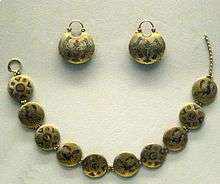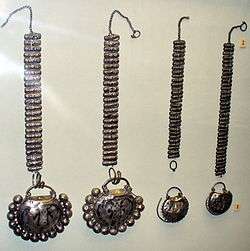Kolt

A pair of kolts featuring two birds flanking the tree of life and a ryasna, a chain of medallions, found in 1842 in or near the Church of the Tithes in Kiev). Cloisonné enamel on Gold. 12th century.

Kolts found in Nizovka, Chernihiv Oblast. 12th century.
Kolt or kolty was a part of a female headgear, hanging on a ryasna at both temples as a sign of family's wealth, common in 11th-13th centuries in Old Rus'. It comprised a pair of metal pieces, joined to form a hollow medallion or star that, presumably, contained a piece of cloth, impregnated with fragrances.
Origin
The origin of the word “kolt” is obscure. As a term, it was introduced in the late 19th century in the course of ethnographic surveys. According to a version it derived from the Ukrainian: ковтки meaning (earrings),[1] also in West-Ukrainian dialects “колток”.[2] In a Novgorod dialect the word “колтки” means pendants of earrings, it was also mentioned in birch bark document No. 644, found in Novgorod, dating back to Novgorod Republic.
References
Further reading
- Pekarskaja, Ljudmila V. (1997). Treasures from Ancient Kiev in the Metropolitan Museum of Art and Dumbarton Oaks. 32 (Metropolitan Museum Journal ed.). New York. pp. 65–75.
- Рыбаков, Б. А. (1971). Декоративно-прикладное искусство Руси X-XIII веков (in Russian). Leningrad: Аврора.
- Жилина, Н. В. (1997). Древнерусские звездчатые колты (схема развития) (in Russian) (Научные чтения памяти В. М. Василенко ed.). Moscow. pp. 140–150.
- Ляусік Н.А. (2003). Ціснёныя колты са збораў ГДГАМ (in Belarusian) (Краязнаўчыя запіскі. Вып. 6 ed.). Grodno. pp. 3–5.
External links
| Wikimedia Commons has media related to Kolty. |
- a kolt in the collection of Kremlin Armory Chamber, Moscow
- a star-shaped kolt in the collection of Kremlin Armory Chamber, Moscow
- a circular kolt in the collection of the Hermitage Museum, St. Petersburg
- a circular silver kolt found in the Berestye archeological site, Belarus, featuring a seed with sprouts
This article is issued from Wikipedia - version of the 3/13/2016. The text is available under the Creative Commons Attribution/Share Alike but additional terms may apply for the media files.